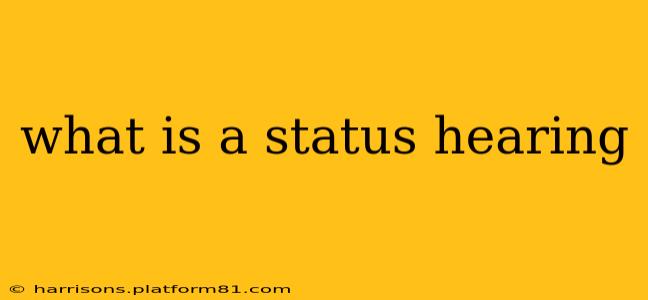A status hearing, often referred to as a status conference, is a relatively brief court proceeding where the judge and the parties involved in a legal case meet to discuss the progress of the case. It's not a trial; instead, it's a check-in to ensure the case is moving forward efficiently and to address any roadblocks. Think of it as a progress report for the legal process. This guide will delve deeper into the purpose, process, and common questions surrounding status hearings.
What is the Purpose of a Status Hearing?
The primary purpose of a status hearing is to keep the case on track. Judges use these hearings to:
- Assess Progress: The judge reviews the progress made since the last hearing or filing. This includes reviewing deadlines met, evidence gathered, and any potential settlements explored.
- Identify Issues: The hearing allows the parties to raise any issues that are hindering the progress of the case. This could involve disagreements on discovery, scheduling conflicts, or other procedural matters.
- Set Deadlines: The judge will often set new deadlines for various tasks, such as filing motions, conducting discovery, or completing expert witness reports.
- Encourage Settlement: The judge might encourage the parties to explore settlement options to avoid a full trial. This is often a significant goal of status hearings, particularly in civil cases.
- Manage Caseload: Status hearings help judges efficiently manage their caseloads by identifying potential problems early on and ensuring cases are progressing smoothly.
What Happens During a Status Hearing?
A status hearing is usually less formal than a trial. It typically involves:
- Brief Overview: Each party (lawyers representing the plaintiff and defendant) provides a brief summary of their progress and any outstanding issues.
- Discussion of Deadlines: The judge discusses any upcoming deadlines and ensures everyone understands their responsibilities.
- Resolution of Disputes: The judge will attempt to resolve any disagreements or conflicts between the parties.
- Scheduling of Future Hearings: The judge will schedule any future hearings or deadlines, setting a plan for the case's continuation.
Who Attends a Status Hearing?
The attendees typically include:
- The Judge: Presides over the hearing and guides the discussion.
- Attorneys for Each Party: Represent their clients and provide updates on the case's progress.
- Sometimes, the Parties Themselves: Although less common, in some cases, the parties involved (plaintiff and defendant) might be required or requested to attend.
How Long Does a Status Hearing Last?
The duration of a status hearing varies greatly depending on the complexity of the case and the number of issues to address. Some hearings may last only a few minutes, while others could extend to an hour or more.
What is the Difference Between a Status Hearing and a Case Management Conference?
The terms "status hearing" and "case management conference" are often used interchangeably, and their functions are largely similar. However, a case management conference may be more comprehensive, involving more detailed discussions about the case's overall strategy and planning.
Is a Status Hearing Necessary?
While not always mandatory, status hearings are common practice in many jurisdictions, particularly in complex or protracted legal cases. They contribute significantly to effective case management and efficient use of court resources.
Can a Status Hearing Be Conducted Remotely?
Due to technological advancements and the need for flexibility, many courts now conduct status hearings remotely via video conferencing. This allows for greater convenience and accessibility for all involved parties.
This comprehensive guide offers a clear understanding of status hearings. Remember that specific procedures may vary slightly depending on the jurisdiction and type of case. If you have any questions about a specific case or legal matter, it's crucial to consult with an experienced legal professional.
